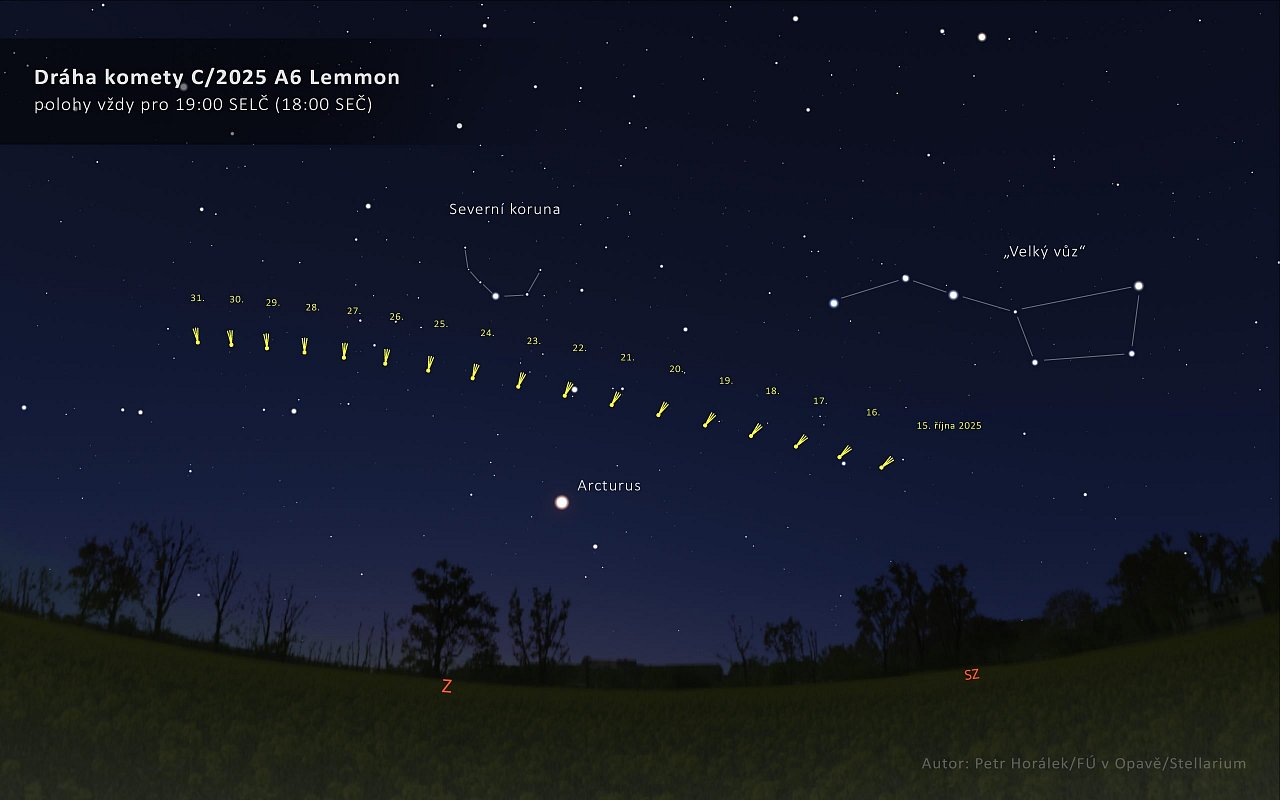
How to observe comet C/2025 A6 Lemmon?
- Lucie Dospivová
- 15.10.2025
Most noticeable in the coming weeks:
Comet C/2025 A6 (Lemmon) was discovered on January 3, 2025, as part of the Mount Lemmon survey system in Arizona (USA). Subsequent observations showed that it is a long-period comet that returned to the Sun after approximately 1,350 years, and thanks to the gravitational effects of the Sun and the large planets, its period will shorten so that it will return again in approximately 1,150 years. During its current return, it will come closest to Earth next week, on Tuesday, October 21, 2025, when it will be about 89 million km away from us (approximately two-thirds of the distance between Earth and the Sun). It will continue to approach our star, reaching its perihelion on November 8, 2025, at a distance of approximately 79 million km. It will be most prominent in the sky between these two dates.
 Comet C/2025 A6 Lemmon low above the horizon below the Big Dipper. Photo: Petr Horálek/Institute of Physics in Opava.
Comet C/2025 A6 Lemmon low above the horizon below the Big Dipper. Photo: Petr Horálek/Institute of Physics in Opava.
Search for stars in the evening using the Big Dipper
Starting today (15th of October), the comet will be increasingly visible in the evening sky, approximately between 7 p.m. and 9 p.m. CEST (between 6 p.m. and 8 p.m. CET after the switch to "winter" time), low above the northwestern horizon. The well-known star cluster "Big Dipper," which is part of the constellation Ursa Major, can help. Until October 18, the comet will move under the imaginary yoke of the celestial wagon. In the following days, the bright star Arcturus, which the curve of the Big Dipper's yoke is pointing towards, will be very helpful. The star is visible at dusk low above the west-northwest horizon, and the comet will fly high above it. Towards the end of October, the more conspicuous arc of the constellation Corona Borealis will help, which the comet will pass from below and gradually begin to project to the left of it (in the constellation Ophiuchus). At that time, it will be difficult to find, as it will only be visible low above the western horizon shortly after dusk and will soon set.
Equip yourself with a small pair of binoculars
Although beautiful photographs of the comet and its jagged tail are already circulating on the internet, it is much more difficult to observe visually. The images are created using light lenses, sensitive sensors, and long exposures, which can capture the comet's structure much better than the human eye can perceive it (and in colors that the eye is unfortunately almost completely insensitive to at night). Therefore, a small telescope, such as hunting binoculars, which can capture more light than the naked eye, is absolutely necessary. The comet appears as a hazy, colorless spot with a noticeable upward elongation from the horizon (away from the Sun, which is below the horizon).
Dark skies and an unobstructed horizon are a must
The quality of the night sky is also very important. You will hardly see the comet from large cities, as excessive light pollution reduces the contrast of the starry sky and makes the comet difficult to identify in the urban sky due to its diffuse appearance. It is therefore necessary to find an observation site far from large cities, tens of kilometers away, where the comet will be easily recognizable against the contrasting sky. The second important thing is its low altitude above the horizon – to see it, you need a place with an unobstructed northwest to west horizon. An elevated place, a hill, or mountains are therefore ideal.
Even though the comet's brightness should be above the threshold of visibility to the naked eye, especially between October 21 and 28, only experienced observers who are well versed in the sky and can distinguish the comet from other faint objects in the dark sky will be able to see it. We cannot expect a bright comet like NEOWISE or Tsuchinshan–ATLAS in the recent past.
Don't rely on apps, visit an observatory!
Various smartphone apps greatly distort the comet's visibility, and an inexperienced observer may easily miss seeing the comet due to misinterpretation of the app (and inability to orient themselves in the night sky). If you want to see the comet at all costs during the next two weeks of its best visibility and you are unable to do so, visit your nearest public observatory when the sky clears. Experts working at public observatories know how to find comets, and observatories are equipped with light-sensitive instruments that can detect at least the head and the brightest part of the comet's tail, even in cities.
Contact details:
Mgr. Petr Horálek
PR spokeperson for european projects at the Institute of physics in OpavaEmail: petr.horalek@slu.cz
Telephone: +420 732 826 853
RNDr. Tomáš Gráf, Ph.D.
Institute of physics in Opava, head supervisor of the observatory WHOO! and UnisphereEmail: tomas.graf@fpf.slu.cz
Telephone: +420 553 684 548
Last news
-
The Geminid meteor shower peaks under favorable conditions
08.12.2025 / ustav -
International researchers joined the 27th RAGtime conference
18.11.2025 / ustav -
Inside the Ememté series: when students become multimedia mentors
14.11.2025 / ustav -
MMT student succeeds at international festival
03.11.2025 / ustav -
How to observe comet C/2025 A6 Lemmon?
15.10.2025 / ustav








